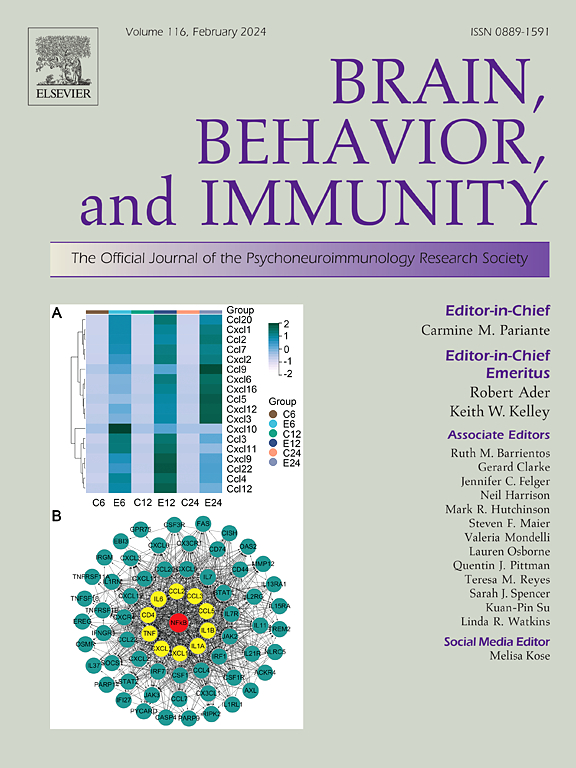Central and peripheral kynurenine pathway metabolites in COVID-19: Implications for neurological and immunological responses
IF 8.8
2区 医学
Q1 IMMUNOLOGY
引用次数: 0
Abstract
Long-term symptoms such as pain, fatigue, and cognitive impairments are commonly observed in individuals affected by coronavirus disease 2019 (COVID-19). Metabolites of the kynurenine pathway have been proposed to account for cognitive impairment in COVID-19 patients.
Here, cerebrospinal fluid (CSF) and plasma levels of kynurenine pathway metabolites in 53 COVID-19 patients and 12 non-inflammatory neurological disease controls in Sweden were measured with an ultra-performance liquid chromatography-tandem mass spectrometry system (UPLC-MS/MS) and correlated with immunological markers and neurological markers. Single cell transcriptomic data from a previous study of 130 COVID-19 patients was used to investigate the expression of key genes in the kynurenine pathway.
The present study reveals that the neuroactive kynurenine pathway metabolites quinolinic acid (QUIN) and kynurenic acid (KYNA) are increased in CSF in patients with acute COVID-19. In addition, CSF levels of kynurenine, ratio of kynurenine/tryptophan (rKT) and QUIN correlate with neurodegenerative markers. Furthermore, tryptophan is significantly decreased in plasma but not in the CSF. In addition, the kynurenine pathway is strongly activated in the plasma and correlates with the peripheral immunological marker neopterin. Single-cell transcriptomics revealed upregulated gene expressions of the rate-limiting enzyme indoleamine 2,3- dioxygenase1 (IDO1) in CD14+ and CD16+ monocytes that correlated with type II-interferon response exclusively in COVID-19 patients.
In summary, our study confirms significant activation of the peripheral kynurenine pathway in patients with acute COVID-19 and, notably, this is the first study to identify elevated levels of kynurenine metabolites in the central nervous system associated with the disease. Our findings suggest that peripheral inflammation, potentially linked to overexpression of IDO1 in monocytes, activates the kynurenine pathway. Increased plasma kynurenine, crossing the blood–brain barrier, serves as a source for elevated brain KYNA and neurotoxic QUIN. We conclude that blocking peripheral-to-central kynurenine transport could be a promising strategy to protect against neurotoxic effects of QUIN in COVID-19 patients.
COVID-19中中枢和外周犬尿氨酸途径代谢物:对神经和免疫反应的影响
受2019冠状病毒病(COVID-19)影响的个体通常会出现疼痛、疲劳和认知障碍等长期症状。犬尿氨酸途径的代谢物已被提出用于解释COVID-19患者的认知障碍。本文采用超高效液相色谱-串联质谱系统(UPLC-MS/MS)测量了瑞典53例COVID-19患者和12例非炎症性神经系统疾病对照者的脑脊液(CSF)和血浆中犬尿氨酸途径代谢物的水平,并与免疫标志物和神经标志物进行了相关性分析。利用先前对130例COVID-19患者进行的研究的单细胞转录组学数据,研究犬尿氨酸通路关键基因的表达。本研究表明,急性COVID-19患者脑脊液中神经活性犬尿氨酸途径代谢物喹啉酸(QUIN)和犬尿酸(KYNA)升高。此外,脑脊液中犬尿氨酸水平、犬尿氨酸/色氨酸比率(rKT)和QUIN与神经退行性标志物相关。此外,色氨酸在血浆中显著减少,但在脑脊液中没有。此外,犬尿氨酸途径在血浆中被强烈激活,并与外周免疫标记物新蝶呤相关。单细胞转录组学显示,在COVID-19患者中,CD14+和CD16+单核细胞中限速酶吲哚胺2,3-双加氧酶1 (IDO1)基因表达上调,与ii型干扰素反应特异性相关。总之,我们的研究证实了急性COVID-19患者外周犬尿氨酸途径的显著激活,值得注意的是,这是第一个确定与该疾病相关的中枢神经系统犬尿氨酸代谢物水平升高的研究。我们的研究结果表明,外周炎症可能与单核细胞中IDO1的过度表达有关,激活了犬尿氨酸途径。血浆犬尿氨酸增加,穿过血脑屏障,作为脑KYNA和神经毒性QUIN升高的来源。我们得出结论,阻断犬尿氨酸外周到中枢的转运可能是一种有希望的策略,可以保护COVID-19患者免受QUIN的神经毒性作用。
本文章由计算机程序翻译,如有差异,请以英文原文为准。
求助全文
约1分钟内获得全文
求助全文
来源期刊
CiteScore
29.60
自引率
2.00%
发文量
290
审稿时长
28 days
期刊介绍:
Established in 1987, Brain, Behavior, and Immunity proudly serves as the official journal of the Psychoneuroimmunology Research Society (PNIRS). This pioneering journal is dedicated to publishing peer-reviewed basic, experimental, and clinical studies that explore the intricate interactions among behavioral, neural, endocrine, and immune systems in both humans and animals.
As an international and interdisciplinary platform, Brain, Behavior, and Immunity focuses on original research spanning neuroscience, immunology, integrative physiology, behavioral biology, psychiatry, psychology, and clinical medicine. The journal is inclusive of research conducted at various levels, including molecular, cellular, social, and whole organism perspectives. With a commitment to efficiency, the journal facilitates online submission and review, ensuring timely publication of experimental results. Manuscripts typically undergo peer review and are returned to authors within 30 days of submission. It's worth noting that Brain, Behavior, and Immunity, published eight times a year, does not impose submission fees or page charges, fostering an open and accessible platform for scientific discourse.

 求助内容:
求助内容: 应助结果提醒方式:
应助结果提醒方式:


